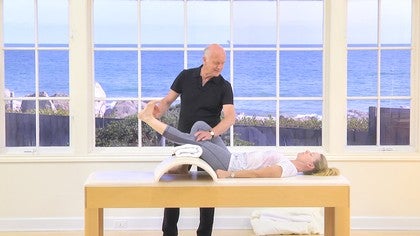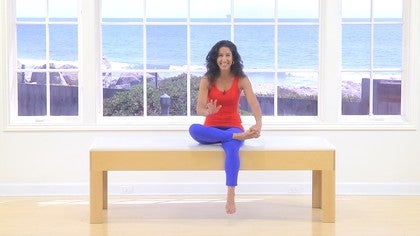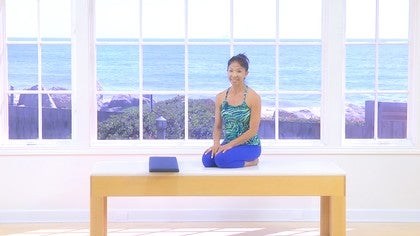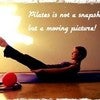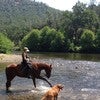Description
About This Video
Transcript
Read Full Transcript
Hi, I'm Kathy Murakami and I'm super excited to share with you a tutorial about assisting the issues surrounding wrist pain and risk discomfort because it's something that I get asked a lot from clients and some of you on PyLadies anytime it sounds like, uh, when we do a lot of the weight bearing exercises, there is discomfort especially in this particular area. So I wanted to share some tips I've found that will probably help you out. So when you are in a weightbearing position with your hands, first of all, I want you to think about your hands as your shoulder blades. So the way that the hands are placed on the floor, when you look at them, you want to be very conscious and exact about the positioning. So I'm going to come here to a window because I'm sure you all have a window or a wall at home and when you practice you can practice in a non weight bearing position.
So the hands you place flat with the index finger pointing straight up and as much surface of the palm touching as possible. Something like this. And I would say you should start out with your hands approximately straight in front of your own shoulders. So actually you can do this in front of a mirror if you're not sure about your placement, the wider your shoulders are, and if you've had shoulder issues, the wider you need to place the hands. Okay, so that's step one. So I'm going to do something about like this. Okay?
You spread the fingers wide. You don't have to have them as wide as possible, but enough so that the webbing is open because you want to feel the energy that comes through your arms, out through your fingers and out in between the webbing emerging. Okay? So there's no kinks in your garden hoses. Then from here, step back a little bit so that you have a weight on your hands and arms and your feet are placed. You can have them. I usually start people who have had legs together and the heels a little bit lifted and you want to organize the legs in relationship to the hips and your spine and your head. All right, so you feel this position and from here inside your body, feel an invisible rubber band from the pinky finger along the lateral side of the arm through the side of the arm pit here crossing the lower tip of your shoulder blades across through the waistline area. There's some facial tissue.
We're connecting down through the hamstring origin all the way down the back of the leg. So this is like a your inner rubber band of support. Then there's also that same rubber band from here coming along, that arm area crossing here under the armpit, through the side of the ribs, your external oblique, your internal oblique through the pelvic floor into your deep abdominals. Or I should say that the other way around, your abdominals to the two pelvic floor inner thighs down the inner leg. That's why I have you on the ball of the foot.
So you have this double x of support from the inside. Okay. Connect all of those lines together and just do some simple breathing. So breathing in for about three, four counts. Exhaling for about three, four counts here so that you can feel what the connection of the hands are through the arms, through the shoulder blades, across the back, down the legs, front and back. All right, so you do that for a few breaths. If you want to challenge yourself a little bit more, you can float one leg off.
This is almost emulating the [inaudible] mat exercise, front support, leg pull front, and then the other side and you want to be very aware in this position that your shoulder blades are not going wide, nor are they collapsing in, nor are they writing up so they are what I like to say, they are parked on your back. You're right in your parking spot. All right. The shoulder blades are really dependent upon the position of the ribs and the position of the ribs are dependent on the position of this part of your spine. This is called the thoracic spine, your upper back, so that's why sometimes to organize the shoulder blades properly, we have to pay attention to what's happening with your spinal column, particularly in this area, but that's a different tutorial. Okay.
After you are pretty sure and I'm feeling your connections here in this position, you can take the angle of the torso a little bit lower. So I always ask the clients, well I'm sure you have a kitchen counter at home. Sure they have a kitchen counter at home. So you're taking your angle maybe a little bit lower. Okay, so now there's a little bit more of weight bearing on your hands and you don't have flat surface necessarily. So that case you want the base of the poem really anchored in relationship to your shoulder blades. All right?
Because you have an invisible challenge here called gravity that's pulling on you from the kitchen counter level. You can take it down to your dining room table, you can take it down to your dining room chair, you can take it down to an auto man and then we will take it down to the floor. So that's what we're going to show you next. Okay. So we're taking this information now down to a more weight bearing, a type of positioning. And what I want to mention here is that, um, not only is the placement, the exact placement of the hands important, you have to remember that the hands, the forearms, the triceps, and the biceps, this entire structure needs to be engaged and rooted into your back.
So many times what I'm seeing in class is the position, correct, but there's nothing going on in the musculature. And then maybe you start getting tired. This happens. This is what I call a head in the feed bag. So you've got a burden yet head out of the feedbag but not so far that you overdo and overcorrect something like this. This is overcompensating. Okay.
I'm in the quadriped position just a lot of times what tends to happen here is a buckling. I don't know if he could see this here, a buckling of the hands away from the floor. So this is where you have to anchor specifically now through the root of the thumb and the root of the index finger. So right. And maybe even the middle finger too. So these three areas are definitely anchored into the mat. I have this, um, foot stopper here because this surface is much firmer than this and especially here you can see how my wrist gets more flexed here.
Of course I can even that out if I really engage my arms. But um, when you're practicing, you may want to have a, the surface that the hands restaurant a lot firmer. Okay? All right. From here, engage your forearms. So if you play a racket sport or whenever you grab something and you have to really use the muscles in your hands, the forearm muscles have to feel as though they're sucking into the bone. So that is super important. Then the eyes of the elbows, the eyes of the elbows here slightly, just slightly spin forward.
I'm not asking you to do something like this. This is too much, but there's a sensation of a little bit of a spin and actually that spin comes from the upper arm bone. So your upper arm bone is slightly spinning, causing the inner eyed is be at maybe a 45 degree angle or so. And then the sensation that the bicep and the triceps are working together, even though the elbow joint is not moving. So bicep of course, you know, with this feeling tricep of course, you know, is this feeling and they have to be in harmony together. So you're already really working a lot. I remember at the wall I said that you're looking at your hands and thinking better. Your shoulder blades are the hands.
And sometimes I even cue in classes, I'll go around to an individual and I'll place my hands right on their shoulder blades and say, now I want you to park your shoulder blades in a manner that if I wanted to do a handstand on your back, you're not gonna let me fall. So their blades are absolutely flat on the back like this board. So that's the feeling, all of that connected together. Then of course you've done all your inner rubber band, your Pele's core work or inner unit work, and then you challenge that may be by, you know, the simple opposite arm and leg type of exercise that you're probably familiar with. So there are a few little tips for you to help to organize the shoulder blades in relationship to your risks after you come off of this weight bearing position. Sometimes you can just take your hands Folger fingers through, keep the elbow still and do this little move is called figure eight breathing of course, and note which thumb is on top because then you're wanting to go in the opposite direction as well, which sometimes can give you a little brain
The Teacher's Corner: Common Aches and Pains
Comments
@ Jessica - what exactly would you like to see regarding shoulders? I'm filming again this summer.....
 ))
))

You need to be a subscriber to post a comment.
Please Log In or Create an Account to start your free trial.
